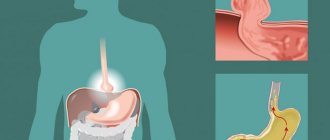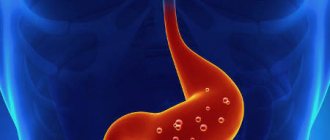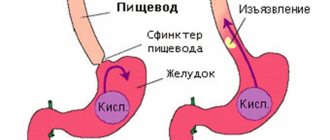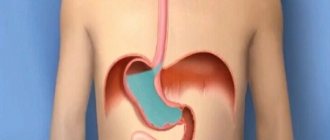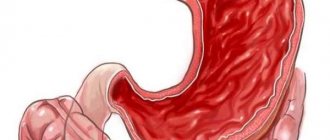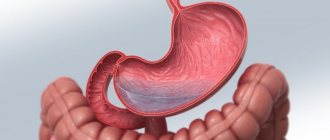Catarrhal inflammation is a type of inflammatory reaction of the mucous membranes, with a predominance of the exudative phase. Morphologically, this type of damage is characterized by hyperemia and edema; exudate with a large number of desquamated epithelial cells is detected on the surface of the pathological focus. Catarrhal inflammation of the esophageal mucosa is catarrhal esophagitis.
In gastroenterological practice, distal catarrhal reflux esophagitis often occurs against the background of gastric cardia insufficiency, the symptoms and treatment of which are determined by the underlying disease.
The inflammatory process occurs in the presence of other gastrointestinal diseases:
- GERD – gastroesophageal reflux disease;
- BDL – biliary dyskinesia;
- gastroduodenitis – inflammation of the stomach and duodenum;
- axial hiatal hernia;
- duodenal-gastric reflux (DGR).
Inflammation can be an indirect sign of GIVP, which is why many gastroenterologists consider this condition a syndrome and not a disease.
Treatment is usually conservative (astringents, enveloping drugs, anesthetics), traditional medicine and physiotherapy are often used.
Catarrhal reflux esophagitis: what is it: symptoms and treatment
Catarrhal reflux esophagitis is an inflammation of the esophageal mucosa under the influence of gastric reflux. The condition occurs when the cardia is insufficient - the lower esophageal sphincter does not close completely and acidic contents from the stomach are refluxed into the esophageal tube.
The process is localized only in the tunica mucosa of the distal part of the esophagus. In the absence of treatment, other parts of the organ may be involved in the process, without spreading to the submucosa and muscular layer. With adequate therapy and diet, the disease can be cured completely, otherwise the process becomes chronic, which is more difficult to treat.
Reflux esophagitis: causes, symptoms and treatment
Cardia failure
If a patient develops esophagitis, cardia failure occurs quite often. In this case, the valve separating the stomach cavity from the esophagus does not close completely. In this case, damage to the lower third of the esophagus is observed: hydrochloric acid has an aggressive effect on the mucous membrane. Sometimes burns and ulcers appear in this area. The most dangerous complication of esophageal burns is malignant degeneration of erosions.
The most characteristic symptoms of cardia failure are:
- attacks of heartburn that occur regularly in a person;
- nausea, vomiting, feeling of fullness in the stomach;
- abdominal pain;
- decreased performance, apathy;
- weakness.
Interesting! Medicine in ampoules Acylok: indications and contraindications
Treatment consists of following a diet, taking specially prescribed antacids, and maintaining a proper lifestyle.
Forms of the disease
Depending on the duration of action of the damaging factor, catarrhal reflux esophagitis (RE) is divided into:
- acute – occurring quickly under strong influence of an unfavorable factor, this form of EC responds well to treatment, while the esophageal mucosa is completely restored;
- chronic - occurs with prolonged exposure to unfavorable factors, the outcome is atrophic processes in the mucosa.
Catarrhal RE has several degrees of severity:
- I degree – single, non-confluent foci of inflammation. There is no clinical picture at this stage - this is distal focal reflux esophagitis.
- II degree – single lesions begin to merge. Clinically, this is manifested by heartburn and pain while eating.
- III degree - the pathological process spreads to most of the organ. Clinical signs appear outside of food intake.
- IV degree is the stage of complications, scar and ulcerative defects appear.
All types of catarrhal inflammation of the esophagus according to the localization of the pathological process are divided into:
- proximal esophagitis – developing in the upper parts of the organ;
- distal esophagitis – developing in the lower sections;
- total esophagitis - involving the entire organ.
Distal catarrhal esophagitis is almost always the result of reflux.
Kinds
What is catarrhal esophagitis and what types does it have? Doctors distinguish these types of pathology depending on the degree of morphological changes in the esophagus:
- Superficial esophagitis - without morphological changes in tissues.
- Edema - this type of disease is characterized by the appearance of severe hyperemia of the mucous membrane.
- The erosive appearance is characterized by the formation of erosions on the surface of the mucosa. Often erosion can reach significant sizes. Sometimes, when the esophagus becomes infected or damaged by chemicals, erosive reflux develops.
- Hemorrhagic esophagitis differs in that the esophageal mucosa is affected by hemorrhages.
- The exfoliative version of the disease occurs as a result of scarlet fever or diphtheria.
- In the necrotic version of the disease, death of organ tissue occurs.
- Allergic or occupational GERD occurs as a result of the action of allergens or harmful industrial substances.
Interesting! Eliminate heartburn in half an hour: use the medicine Omez Insta
The correct diagnosis can only be made by a doctor after appropriate diagnostics.
Causes
Causes contributing to the occurrence of the disease may be:
- injuries (mechanical, chemical, thermal);
- infections (acute and chronic);
- somatic diseases
Normally, the lower esophageal sphincter (LES) helps move food into the stomach and prevents it from moving back. If the functioning of the LES is disrupted, the opening between the esophagus and the stomach remains completely or partially open at all times. Cardiac failure develops.
As a result, the stomach contents regurgitate into the esophagus. Normally, the contents of the stomach periodically enter the esophagus, but if the protective mechanisms (clearance - the ability to self-cleanse, neutralizing the effect of mucus and saliva) work normally, the disease does not occur.
When the protective mechanisms are depleted, H+ ions of the stomach, acting on the esophageal mucosa, cause inflammation, and GERD occurs. Catarrhal inflammation of the esophagus develops, and then (if the disease is not treated), more severe forms of esophagitis.
Distal EC most often does not develop separately, but against the background of other gastrointestinal diseases. In order to treat catarrhal reflux esophagitis, the causes of the pathology are eliminated - the underlying disease is treated.
Terminal form of the disease
Chronic catarrhal terminal esophagitis sometimes develops in newborns who have suffered oxygen starvation. The manifestations of this disease are dangerous: it is characterized by numerous pinpoint hemorrhages and erosions. Children experience the following symptoms:
- very frequent and severe hiccups;
- vomiting (often gushing);
- poor sleep;
- weight loss.
In adults, the symptoms of this form of pathology are as follows:
- belching (undigested food comes out);
- whitish coating on the tongue;
- vomit;
- severe pain in the abdominal area, worsening when lying down.
Important! The terminal stage of the disease can be dangerous, especially if the patient has gastritis or ulcers. Therefore, if clinical symptoms of an “acute abdomen” appear, it is necessary to call emergency assistance.
Symptoms of catarrhal reflux esophagitis
For a long time, catarrhal reflux esophagitis can be asymptomatic or with minimal, unexpressed symptoms. The main symptoms of distal catarrhal RE are discomfort and burning in the chest, aggravated by eating, especially when eating hard foods.
As the pathology develops, stabbing and burning pains occur. The pain is localized retrosternally (behind the sternum in the projection of the esophagus), radiates to the shoulder blades and neck, and intensifies while eating.
Patients are concerned about heartburn, increased salivation (salivation), and belching.
A pronounced form of reflux esophagitis against the background of gastric cardia insufficiency is characterized by:
- general weakness, nervousness;
- heartburn;
- belching;
- pain in the retrosternal region and in the stomach, aggravated by eating;
- nausea;
- increased salivation;
- paroxysmal cough;
- change in voice timbre.
Symptoms
Note! One of the main signs of the disease is the appearance of sharp pain in the chest, worsening at night. It increases after sour, salty, spicy and hot foods.
Common symptoms of terminal esophagitis are as follows:
- heartburn;
- belching;
- general weakness;
- sensation of a lump in the chest;
- nausea;
- hypersalivation;
- dizziness.
In the later stages, the patient develops ulcers and scars on the esophagus. Due to adhesions, the tube gradually shortens, causing severe pain. The narrowing of this organ provokes severe congestion in the stomach cavity.
Interesting! Causes and treatment of chronic esophagitis at home
What is chronic catarrhal reflux esophagitis?
Acute catarrhal esophagitis most often ends in recovery or becomes chronic. The outcome of the chronic process can be atrophy of the mucous membrane.
Chronic catarrhal reflux esophagitis is a chronic inflammation of the tunica mucosa of the terminal (distal) part of the esophagus, caused by prolonged exposure to gastric reflux on it against the background of cardia insufficiency. In most cases, the pathology occurs in the presence of other gastrointestinal diseases (hiatal hernia, gastritis, duodenitis, GHD).
In order to determine how to treat a patient, they begin by finding out the causes of the pathology and eliminating them. In this case, treatment of the inflammatory process in the terminal esophagus depends on the success of therapy for the underlying disease. Most often, astringents, enveloping substances, antispasmodics are prescribed, and painkillers are added if necessary.
Treatment
Complex therapy of esophagitis is necessary. To eliminate the cause of the disease, you need to adjust your diet and give up bad habits.
Coffee, chocolate, and pickles should be excluded from the menu. The following is indicated as drug therapy:
- sea buckthorn oil;
- antacids - Almagel, Maalox, Phosphalugel;
- Omeprazole;
- Diazolina;
- Tserukala;
- De-Nola;
- painkillers;
- antispasmodics;
- anti-inflammatory drugs;
- corticosteroids.
Prevention of esophagitis consists of following a diet, physical and mental activity. Wearing tight clothing and underwear is prohibited.
Physical therapy is indicated. Patients should categorically stop drinking alcohol and smoking.
Diagnostics
If there is a suspicion of catarrhal inflammation of the esophagus, then the main diagnostic method is endoscopy of the esophagus and biopsy.
The most typical signs of catarrhal esophagitis during endoscopic examination are edema and hyperemia; if such changes are detected in the distal esophagus, then most often there are signs of insufficiency of the gastric cardia and GERD.
It is better to perform endoscopy outside the acute stage, so as not to cause additional trauma to the esophageal mucosa. Endoscopic diagnosis involves a biopsy of the mucous membrane at the site of the lesion, followed by histological examination to exclude oncological process and metaplasia.
An X-ray of the esophagus reveals swelling of the folds and uneven contours of the mucous membrane.
Esophageal manometry is performed to study the motility of the esophagus.
In the general examination scheme, intraesophageal pH measurement is required to identify GERD, determine the frequency and duration of episodes of reflux from the stomach into the distal esophagus.
Laboratory diagnosis in the case of an inflammatory process in the esophagus is not very informative. When analyzing peripheral blood, slight neutrophilic leukocytosis may be detected.
Signs of catarrhal esophagitis in acute and moderate form
Acute esophagitis is characterized by a pronounced course. The following signs of catarrhal esophagitis in its acute form are known:
- discomfort when swallowing food;
- burning pain in the esophagus, increasing as food moves through it;
- neck pain;
- heartburn with sour, unpleasant belching;
- white coating on the surface of the tongue;
- excessive salivation;
- fever, chills, malaise.
The acute form of the disease can be complicated by abscesses, perforation of the esophagus, purulent mediastinitis, esophageal stricture, and focal dysplasia.
In gastroenterology, specialists use the term “moderate catarrhal esophagitis” to designate the form of this inflammatory process, which is relatively considered normal and does not belong to the pathologies. As a rule, with such an inflammatory process, gentle nutrition is prescribed for 2-3 days, after which, in most cases, impaired digestive functions are restored without taking medications.
Catarrhal reflux esophagitis: treatment
In the treatment of patients with catarrhal reflux esophagitis, it is necessary to eliminate the cause that caused the pathology.
When diagnosed with GERD of ulcerogenic (ulcerative) origin or due to gastroduodenitis, it is necessary to reduce the concentration of H+ ions in the refluxate and reduce the likelihood of reflux. For this we use:
- Antacids (Gastal, Phosphalugel, Maalox). Recently, alginates (Topalkan, Gaviscon) have been used more often.
- IGR (Cimetidine, Ranitidine, Famotidine, Roxatidine).
- PPI (Omeprazole, Pantoprazole, Rabeprazole).
- Prokinetics (Ganaton and Domperidone)
The dose of drugs for chronic distal reflux esophagitis is selected individually.
In the treatment of acute focal esophagitis, medications are used:
- drugs that cause surface coagulation of proteins, thereby creating a protective film on the surface of the mucosa (colloidal silver, tannin);
- medications that form colloidal solutions and suspensions with water that protect the mucous membrane (bismuth nitrate, calcium carbonate);
- Anesthetics are used to reduce the intensity of pain.
Treatment with traditional medicine
Herbal medicine can smooth out the manifestations of catarrhal inflammation, especially in the first stages of the development of the disease. Herbs can enhance regenerative processes and reduce the inflammatory response.
The question of whether catarrhal reflux esophagitis can be cured only with traditional medicine raises great doubts, because along with the process in the esophagus, it is necessary to treat the diseases accompanying it (GERD, gastroduodenitis, GHD), and here more traditional therapy is needed.
The inflammatory reaction is reduced by: calamus root, oak bark, St. John's wort.
A mixture of honey and aloe promotes regeneration.
Reduce pain: chamomile, plantain, yarrow.
Causes of the disease
Why does catarrhal esophagitis occur? There are many reasons that lead to the development of this disease. Let's look at the most common ones.
Errors in nutrition
Many diseases, including esophagitis, arise due to poor nutrition:
- the person ate a lot of rough or heavy food;
- preferred something sour, pickled, smoked or peppered;
- constantly ate too hot or very cold dishes;
- abused alcohol;
- he constantly drank too strong tea or coffee.
Exposure to aggressive substances
Often the cause of the disease can be exposure to various chemicals, for example, acid vapors, caustic alkalis, moles of heavy metals. In some cases, the disease can also occur due to hydrochloric acid. With gastroesophageal reflux disease, the contents of the stomach enter the esophagus and irritate its mucosa. Sometimes this happens with severe vomiting or prolonged intubation of the patient. There is also congestive esophagitis, which occurs because food debris accumulates in the lumen of the esophagus and irritates it.
Various diseases
We have already mentioned that the cause of catarrhal esophagitis can be GERD, but this is not the only disease that leads to damage to the mucosa. Sometimes it can be a manifestation of various infectious diseases, such as scarlet fever or diphtheria.
Sometimes the disease is a consequence of gastritis or gastroenteritis and other diseases. Resection of the stomach or stitching of an ulcer, cancer and pregnancy can also affect a person’s well-being. After such an operation, gastric juice is regularly thrown into the lower part of the esophagus, which causes its inflammation.
In addition, there is an allergic type, which is especially common in children suffering from food allergies or bronchial asthma. Sometimes the esophageal mucosa is damaged during an endoscopic examination. Separately, it is worth mentioning patients with immunodeficiency, which can appear after organ or tissue transplantation, after radiation therapy, treatment with cytotoxic drugs, and so on. Then inflammation can be caused by various viruses and fungi, for example, influenza, herpes, and Candida fungi.
What is dangerous about catarrhal reflux esophagitis?
With timely and correct treatment and adherence to the prescribed diet, the prognosis for catarrhal reflux esophagitis is favorable. If left untreated, the disease can become chronic, characterized by alternating exacerbations and remissions. As the disease progresses, complications are possible:
- purulent inflammation;
- scar changes;
- perforation of the esophagus.
Complications of catarrhal reflux esophagitis are dangerous not only to health, but also to life.

